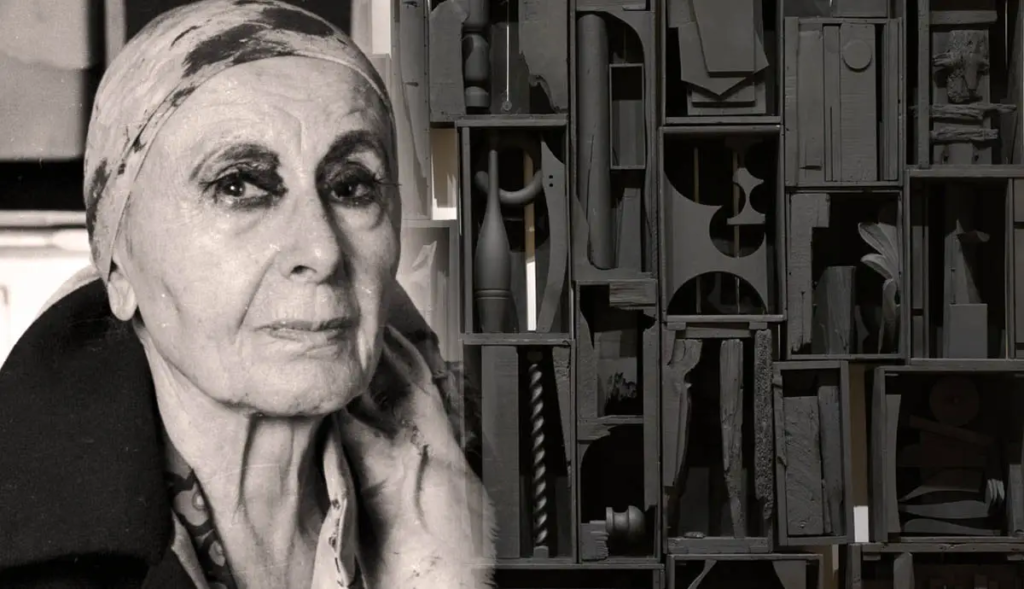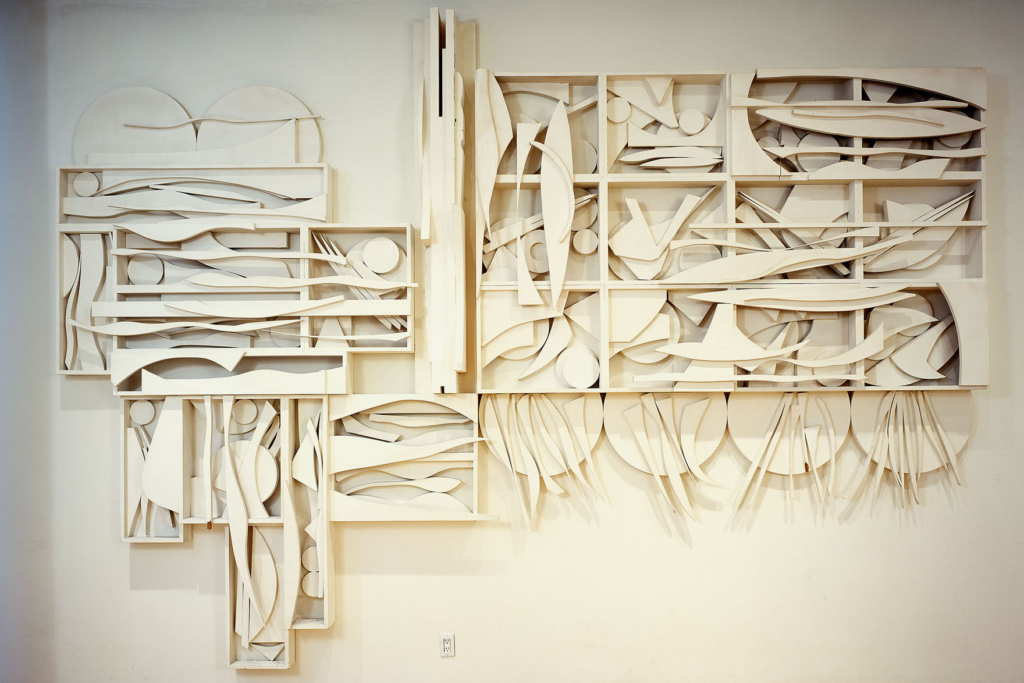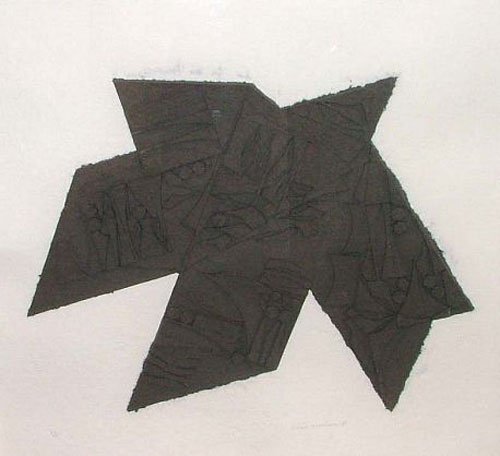Louise Nevelson BIOGRAPHY

Early Life and Education of Louise Nevelson
Louise Nevelson was born in 1899 in Pereiaslav, Ukraine. Her family immigrated to the United States when she was a child, settling in Rockland, Maine. Nevelson showed an early interest in art and attended the School of Fine Arts at Columbia University in New York City. However, she did not receive a formal degree, as she felt the traditional art education system needed to align with her artistic vision.
Despite this, Nevelson continued pursuing her passion for art and experimenting with different mediums and styles. She explored painting, sculpture, and collage, often incorporating found objects and discarded materials. Nevelson’s art was heavily influenced by her experiences as an immigrant and her fascination with the urban environment.
In the 1950s, Nevelson gained recognition for her unique style and innovative use of materials. She started creating large-scale sculptures using wood, which she would paint entirely in black or white. These sculptures, often composed of many individual pieces, were known for their abstract forms and intricate details.
What is Louise Nevelson known for?

Louise Nevelson was a renowned American sculptor known for her unique and innovative approach to sculpture. She is famous for her monumental, abstract sculptures from found objects and wood.
Nevelson’s work often consisted of large-scale assemblages of various wooden pieces, which she painted in monochromatic colors, typically black or white. Her sculptures were characterized by their bold and intricate designs, creating complex and captivating visual compositions.
Nevelson’s work challenged traditional notions of sculpture and pushed the boundaries of what could be considered art. She is regarded as one of the most famous female artists of the 20th century and has left a lasting impact on the world of sculpture.
Career highlights

When did Louise Nevelson start art?
An American sculptor, Louise Nevelson began her artistic career in the 1930s. She dabbled in painting before transitioning to sculpture, her primary medium. Nevelson’s work was heavily influenced by her upbringing in a Russian Jewish immigrant family and her experiences as a woman artist in a male-dominated art world.
Getting Fame
Nevelson’s work quickly gained attention, and she became one of the most prominent female artists of her time. Her sculptures were exhibited in galleries and museums worldwide, and she received numerous awards and honors throughout her career.
In addition to her artistic achievements, Nevelson advocated for women’s rights and equality in the art world. She believed that female artists should be recognized and celebrated for their contributions and actively fought against the gender biases prevalent in the art world at the time.
Who inspired Louise Nevelson?
Nevelson was particularly inspired by artists such as Piet Mondrian and Kazimir Malevich, who explored geometric abstraction and bold colors. She also found inspiration in African and pre-Columbian art, as well as in the works of European Surrealists.
However, it is essential to note that while Nevelson drew inspiration from these artists and movements, she developed her unique style and approach to sculpture. She became known for her large-scale assemblages, made from found objects such as wooden scraps and discarded furniture. Nevelson’s sculptures often featured intricate patterns and arrangements, creating visually striking and thought-provoking pieces.
Why did Louise Nevelson paint her sculptures black?
Nevelson’s use of black was particularly significant in her work. She described black as a color that contained all other colors, representing all things’ unity and interconnectedness.
Using black as her primary color, Nevelson created a sense of mystery and ambiguity in her sculptures. The absence of color allowed viewers to focus on the forms and shapes of the artwork, inviting them to interpret and engage with the pieces in their way.
Louise Nevelson List of Work

What art did Louise Nevelson make?
Louise Nevelson was an American artist known for her sculptural assemblages. She primarily worked with found objects, such as pieces of wood and other discarded materials, which she would combine and arrange to create large-scale artworks.
Nevelson’s sculptures were often monochromatic and abstract, with intricate patterns and textures. She was known for using black paint, which she would apply to her sculptures to create a unified and cohesive appearance.
Various artistic movements, including Cubism and Surrealism, influenced her. Her sculptures can be found in museums and galleries worldwide, and her unique approach to art continues to inspire and influence artists today.
How does Louise Nevelson use color in her work?
Louise Nevelson is known for her unique use of color in her work. She often used black, white, or shades of gray to create a dramatic contrast and emphasize the form and texture of her sculptures.
Nevelson’s use of color was not limited to the actual physical color of the materials she used. She also employed painting, staining, and patina to alter the color and create different effects. By manipulating the color of her sculptures, Nevelson could evoke other emotions and develop a sense of depth and movement.
In addition to her use of color, Nevelson incorporated light and shadow into her sculptures to enhance their visual impact. The play of light and shadow on her sculptures’ different surfaces and textures added another layer of depth and complexity to her work.
Notable Artworks
Some of Nevelson’s most notable artworks are:
Environments | These immersive installations consist of intricately assembled and painted wooden objects, creating a sense of mystery and awe. |
Chapel of the Good Shepherd | One of her most famous environments is the “Chapel of the Good Shepherd,” exhibited at the Museum of Modern Art in New York in 1959. This groundbreaking artwork solidified Nevelson’s reputation as a pioneering sculptor. |
Sky Cathedral | It is a three-dimensional wall sculpture with various wooden forms painted in black. This piece exemplifies Nevelson’s exploration of light and shadow and her ability to transform ordinary materials into extraordinary artworks. |
Other include:
Atmosphere and Environment X | 1969 |
Clown tight rope walker | 1942 |
Transparent Horizon | 1975 |
Night Presence II | 1976 |
Dawn’s Presence | 1975 |
Lunar Landscape | 1960 |
Full Moon | 1980 |
Night Tree | 1971 |
Night Sail | 1985 |
Untitled | 1970 |
Exhibitions
Nevelson’s artworks have been showcased in numerous exhibitions around the world. She had solo exhibitions at prestigious institutions such as the:
Whitney Museum of American Art in New York
Guggenheim Museum in New York
Museum of Fine Arts in Houston
Her works have also been featured in group exhibitions alongside prominent artists, solidifying her place in the art canon.
Awards
Throughout her career, Nevelson received several prizes for her artistic achievements. She was the recipient of numerous awards, including the:
1985 | National Medal of Arts |
1973 | Edward MacDowell Medal |
These honors reflect Nevelson’s significant impact on the art world and her lasting legacy as an innovative and influential sculptor.
Follow Louise Nevelson on social media
Instagram: https://www.instagram.com/louise.nevelson/
More about Louise Nevelson
Foundation: https://louisenevelsonfoundation.org/

